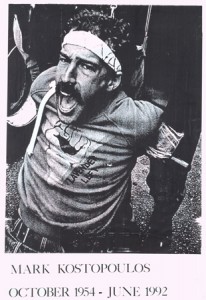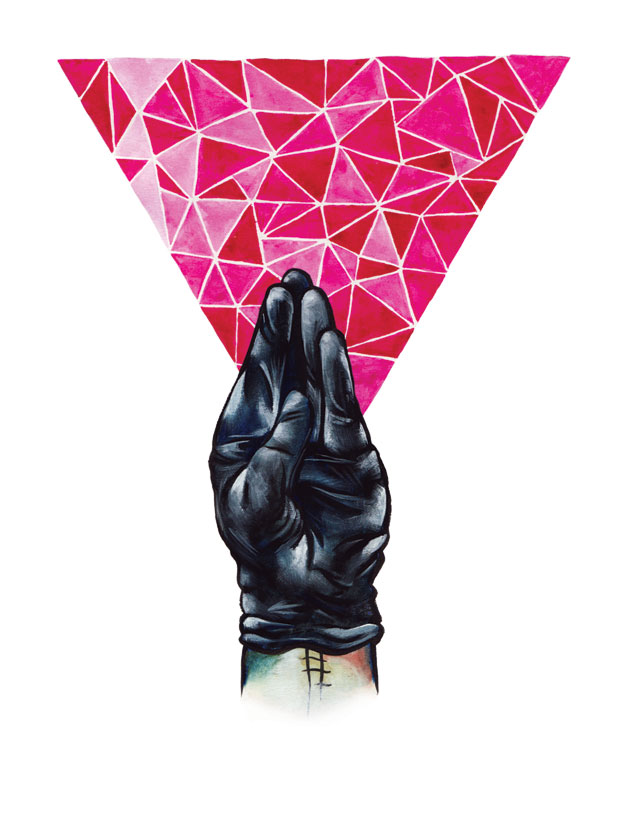Raised fists in activist settings symbolize strength, unity, resistance, and community. To many queer communities, fists themselves have additional meanings: while often one thinks of hitting or violence, additional meanings lurk pruriently behind the surface. After raising for LGBTQ rights throughout the 1980s, and for AIDS activism in the 1990s, a confluence of fists and safer sex rhetoric emerged visually through the production of images of raised fists in gloves in the late 2010’s.
 In the late 1980’s and early 1990s, queer artist groups like Gang, Gran Fury, Dyke Action Machine!, fierce pussy, OutPost, Anonymous Queers, Camp Out and more pulled artists, energy, anger and ideas from activist groups including Queer Nation, ACT UP, Women’s Action Coalition, Lesbian Avengers, Pink Panthers, Lavender Panthers, and the Lavender Left [pictured].
In the late 1980’s and early 1990s, queer artist groups like Gang, Gran Fury, Dyke Action Machine!, fierce pussy, OutPost, Anonymous Queers, Camp Out and more pulled artists, energy, anger and ideas from activist groups including Queer Nation, ACT UP, Women’s Action Coalition, Lesbian Avengers, Pink Panthers, Lavender Panthers, and the Lavender Left [pictured].
This t-shirt of the group Lavender Left, on which there is little research or documentation, was a small group of lesbian and dyke identified individuals who did direct actions protesting the treatment of people with HIV/AIDS. In 1988, this photo of AIDS activist Mark Kostopoulos being restrained [perhaps arrested?] was taken, and we see that his sweatshirt bears a logo: a raised fist in an upside-down triangle, with the words “Lavender Left†on the right side. The image itself is a combination of icons: the raised fist, of course, to invoke and symbolize resistant group power as demonstrated by a marginalized or oppressed group. The fist is in an illustrated, thumb-over convention. The upside down triangle is a commonly used symbol of gay liberation, and is often printed in a pink or purple color.
 A fist like the Lavender Left’s logo and other well-known queer activist images from that time like SILENCE = DEATH, which includes a pink triangle is Fist Triangle. In 2012, SF-based visual artist Lex Non Scripta created Fist Triangle, which looks quite similar, with one major exception: the denotation is the sexual act of fisting, not the resistant act of punching. Non Scripta’s raised fist is wearing a black glove and instead of fingers curled, the hand is shaped in the position one uses when one is going to enter a body with it—fingers shaped into a point, thumb tucked in. This is an image that manifested as an illustration and print after it was first made as a stencil. Generated for “Best Revenge, a giant, roving spectacle of art and performance with 35 artists and 5 different locations about building community and resisting assimilation, that [NonScripta] co-organized with Caitlin Sweet for the National Queer Arts Festival.”
A fist like the Lavender Left’s logo and other well-known queer activist images from that time like SILENCE = DEATH, which includes a pink triangle is Fist Triangle. In 2012, SF-based visual artist Lex Non Scripta created Fist Triangle, which looks quite similar, with one major exception: the denotation is the sexual act of fisting, not the resistant act of punching. Non Scripta’s raised fist is wearing a black glove and instead of fingers curled, the hand is shaped in the position one uses when one is going to enter a body with it—fingers shaped into a point, thumb tucked in. This is an image that manifested as an illustration and print after it was first made as a stencil. Generated for “Best Revenge, a giant, roving spectacle of art and performance with 35 artists and 5 different locations about building community and resisting assimilation, that [NonScripta] co-organized with Caitlin Sweet for the National Queer Arts Festival.”
  One year later, the NYC Dyke March used a raised fist – with a thumb tastefully tucked in – for its 2013 logo. It exists in parallel to a queer cultural refocus on 1990’s activist anger and honors deep connections between lesbians’ places in HIV/AIDS support work and the history of using sexualized in-your-face images as a form of cultural resistance. In this context artist and RISD professor Cat Stephens created this image for the annual Dyke March in New York City, itself an activist space contesting assimilationist lgbtq cultures.
 One year later, the NYC Dyke March used a raised fist – with a thumb tastefully tucked in – for its 2013 logo. It exists in parallel to a queer cultural refocus on 1990’s activist anger and honors deep connections between lesbians’ places in HIV/AIDS support work and the history of using sexualized in-your-face images as a form of cultural resistance. In this context artist and RISD professor Cat Stephens created this image for the annual Dyke March in New York City, itself an activist space contesting assimilationist lgbtq cultures.
The creation of activist ephemera is as much about the presence of bodies as it is about messages – t-shirts, buttons, and patches are worn, placards are held, guerilla posters are present in the streets and witnessed. Tactics of activist art are as much about affect and human presence as they are about messages demanding some kind of change or sharing information. This is a special and queer confluence of meaning: the prurient use of hands, and fists specifically, as sexual instruments and the body-centered social space which activist ephemera exist in.
*********
Archived Raised Fists covered in this article:
- Fist Triangle: http://www.raisedfist.femmetech.org/items/show/40
- Lavender Left: http://www.raisedfist.femmetech.org/items/show/41
- Dyke March 2013: http://www.raisedfist.femmetech.org/items/show/31
